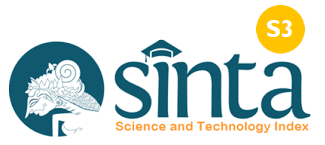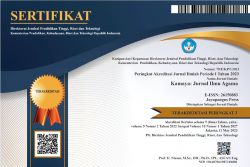Aspek Semantik Teks-Teks Dongeng Skriptorium Pakualaman
Studi Naskah Sĕstra Agĕng Adidarma (Pi.35)
DOI:
https://doi.org/10.37329/kamaya.v8i1.3937Keywords:
Folktales, Philology, Narrative, Pakualaman, SemanticAbstract
The Sĕstra Agĕng Adidarma manuscript (abbreviated as SAA) with the code Pi.35 is a manuscript written in the mid-19th century in Pakualaman, Yogyakarta. It contains several texts, including various folktales. The aim of this study is to identify the number of folktale texts in the SAA manuscript and to analyze them narratively to uncover their structural composition. The theory employed is philology, supported by the narrative structure approach developed by Tzvetan Todorov, particularly focusing on semantic aspects. The benefit of this research is to present the distinctive characteristics of folktale texts from Pakualaman. The results show that there are 26 folktale texts in the SAA manuscript. The semantic aspects of the texts indicate that formally, the texts are composed in the form of macapat verse poetry. The chosen opening tembang (verse forms) include: Pangkur (2 texts), Sinom (8 texts), Asmaradana (6 texts), Dhandhanggula (7 texts), Gambuh (3 texts). The folktales convey allegorical meanings through human and animal characters. Substantively, the folktales in the SAA manuscript reflect aspects of human life, including traits such as character, deceit, incitement, gratitude, carelessness, obedience to orders or prohibitions, leadership, loyalty, justice, and inheritance.
References
Arps, B. (1992). Tembang in Two Traditions: Performances and Interpretation of Javanese Literature (Tesis). Rijksuniversiteit te Leiden.
Behrend, T. E. (Ed.). (1990). Katalog Induk Naskah-Naskah Nusantara Jilid 1: Museum Sonobudoyo. Jakarta: Djambatan.
Chambert-Loir, H. (1999). Sadur: Sejarah Terjemahan di Indonesia dan Malaysia. Jakarta: Kepustakaan Populer Gramedia.
Danandjaja, J. (1994). Folklor Indonesia: Ilmu Gosip, Dongeng, dan Lain-Lain. Jakarta: Grafiti Press.
Damono, S. D. (1979). Sastra Lisan Indonesia. Jakarta: Departemen Pendidikan dan Kebudayaan.
Girardet, N. (1983). Descriptive Catalogue of the Javanese Manuscripts and Printed Books in the Main Libraries of Surakarta and Yogyakarta. Wiesbaden: Franz Steiner Verlag GMBH.
Lindsay, J., Soetanto, R. M., & Feinstein, A. (1994). Katalog Induk Naskah-Naskah Nusantara Jilid 2: Kraton Yogyakarta. Jakarta: Yayasan Obor Indonesia.
Mulder, N. (1996). Inside Indonesian Society: Cultural Change in Java. Yogyakarta: Kanisius.
Propp, V. (1968). Morphology of the Folktale. Austin: University of Texas Press.
Rahmat. (2006). Sěstra Agěng Adidarma: Perbandingan Těmbang, Carita, dan Těmbung (Suntingan Teks dan Terjemahan) (Skripsi). Yogyakarta: Program Studi Sastra Nusantara, FIB Universitas Gadjah Mada.
Robson, S. (1992). Wawasan Nusantara dalam Kesusastraan Jawa. Jakarta: Pustaka Jaya.
Saktimulya, S. R. (Ed.). (2005). Katalog Naskah-Naskah Perpustakaan Pura Pakualaman. Jakarta: Yayasan Obor Indonesia.
Saktimulya, S. R. (2016). Naskah-Naskah Skriptorium Pakualaman. Jakarta: Kepustakaan Populer Gramedia bekerja sama dengan École Française d’Extrême-Orient, Perpustakaan Widyapustaka, Pura Pakualaman.
Sangidu. (2016). Tugas Filolog: Teori dan Aplikasinya dalam Naskah-Naskah Melayu. Yogyakarta: Gadjah Mada University Press.
Sudibyo. (2015). Filologi: Sejarah, Teori, dan Paradigma. Yogyakarta: Jurusan Sastra Indonesia FIB Universitas Gadjah Mada dan Masyarakat Pernaskahan Nusantara Cabang Yogyakarta.
Sutardjo, I. (2016). Tembang Jawa (Macapat). Solo: Bukutujju.
Teeuw, A. (1984). Sastra dan Ilmu Sastra: Pengantar Teori Sastra. Jakarta: Pustaka Jaya.
Todorov, T. (1982). Introduction to Poetics (R. Howard, Trans.). Minneapolis: University of Minnesota Press.
Todorov, T. (1985). Tata Sastra (O. K. S. Zaimar, A. Djokosuyatno, & T. Bachmid, Trans.). Jakarta: Djambatan.
Utami, K. M. (2006). Analisis Struktur Naratif Cerita Binatang dalam Sěstra Agěng Adidarma [Pupuh XL (Bait 6–12), XLI (Bait 14–16), XLIII, XLIV, dan LXVI–LXXX] (Skripsi S1). Yogyakarta: Sastra Nusantara, FIB Universitas Gadjah Mada.
Zoetmulder, P. J. (1983). Kalangwan: Sastra Jawa Kuno Selayang Pandang. Jakarta: Djambatan.
Downloads
Published
How to Cite
Issue
Section
License
Copyright (c) 2025 Kamaya: Jurnal Ilmu Agama

This work is licensed under a Creative Commons Attribution-ShareAlike 4.0 International License.
An author who publishes in the Kamaya : Jurnal Ilmu Agama agrees to the following terms:
- Author retains the copyright and grants the journal the right of first publication of the work simultaneously licensed under the Creative Commons Attribution-ShareAlike 4.0 License that allows others to share the work with an acknowledgement of the work's authorship and initial publication in this journal
- Author is able to enter into separate, additional contractual arrangements for the non-exclusive distribution of the journal's published version of the work (e.g., post it to an institutional repository or publish it in a book) with the acknowledgement of its initial publication in this journal.
- Author is permitted and encouraged to post his/her work online (e.g., in institutional repositories or on their website) prior to and during the submission process, as it can lead to productive exchanges, as well as earlier and greater citation of the published work (See The Effect of Open Access).
Read more about the Creative Commons Attribution-ShareAlike 4.0 Licence here: https://creativecommons.org/licenses/by-sa/4.0/.





